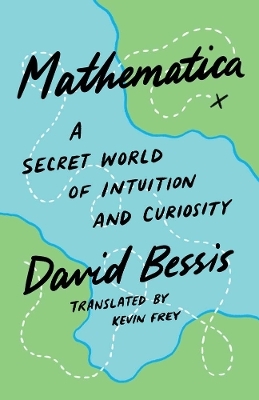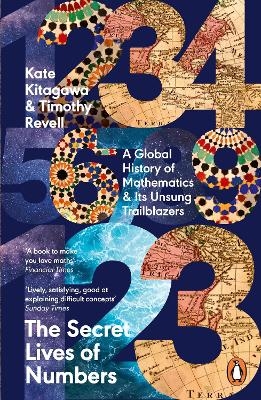
Vector
A surprising story of space, time, and mathematical transformation
Seiten
2024
UNSW Press (Verlag)
978-1-76117-008-9 (ISBN)
UNSW Press (Verlag)
978-1-76117-008-9 (ISBN)
- Keine Verlagsinformationen verfügbar
- Artikel merken
A celebration of the seemingly simple idea that allowed us to imagine the world in new dimensions - sparking both controversy and discovery.
'The story I'll tell here is about the evolution of the way we humans record and make sense of all the data that swirl around us...'
Vector takes readers on an extraordinary 5000-year journey through the human imagination. The stars of this book, vectors and tensors, are unlikely celebrities. Yet mathematician and science writer Robyn Arianrhod shows how they enabled physicists and mathematicians to think in a brand-new way. They inspired James Clerk Maxwell to usher in the wireless electromagnetic age; Albert Einstein to predict the curving of space-time and the existence of gravitational waves; Paul Dirac to create quantum field theory; and Emmy Noether to connect mathematical symmetry and the conservation of energy. Today, you're likely relying on vectors or tensors each time you pick up your mobile phone, use a GPS, or search online.
In Vector, Robyn Arianrhod shows the genius required to reimagine the world - and how a clever mathematical construct can dramatically change discovery's direction.
'In Vector, Arianrhod shows, with beautiful ease, that maths is not some foreign world only geeks inhabit. It is the world around us.' Adam Spencer, author of Adam Spencer's Big Book of Numbers: Everything you wanted to know about the numbers 1 to 100
'Arianrhod's Vector, a masterpiece of science exposition, reads as a welcoming cognitive cliffhanger tour of vectors, their generalizations, and their accompanying symbolic tools of mathematical physics, all dovetailing through germane history vignette accounts of astonishing connections and applications.' Joseph Mazur, author of The Clock Mirage: Our Myth of Measured Time
'A vector is quantity that has magnitude and, crucially, direction. This idea has enabled physicists and mathematicians to imagine and describe the world in new dimensions. The author traces the influence of vectors over the past 5,000 years, and why vectors (and tensors) are still relevant today.' The Bookseller
'There have been lots of books about the evolution of modern physics: from Newton to Maxwell to Einstein and on to quantum theory. But seldom does an author pay attention to the mathematical revolutions that made those physical theories possible. Only as the mathematical toolkit expanded from simple scalars to include such tools and ideas as quaternions and vectors and tensors could physicists and mathematicians find the language to describe an increasingly bewildering universe. Arianrhod does a remarkable job telling the story of the mathematical revolution under the hood, the engine that drove the physics revolutions of the nineteenth and twentieth centuries; the result is a book well worth your time.' - Charles Seife, author of Zero: The Biography of a Dangerous Idea
'"If all mathematics disappeared," physicist Richard Feynman opined, "it would set physics back precisely one week." To which mathematician Mark Kac retorted, "Precisely the week in which God created the world." Arianrhod persuades us that vectors and tensors are among those creations. Students and teachers should read this excellent book together.' - Marjorie Senechal, editor-in-chief of The Mathematical Intelligencer
'With a flair for exposition that makes the complex simple, and a gift for storytelling, Arianrhod is without peer in conveying the beauty, and power, of mathematics. William Rowan Hamilton, James Clerk Maxwell, and Albert Einstein come alive in this dramatic tale of a simple idea that changed our world.' - Amir Alexander, author of Infinitesimal: How a Dangerous Mathematical Theory Shaped the Modern World
'Everyone understands what it means to move at some particular speed in some particular direction. But it took a long time to start thinking of such behavior in terms of a single clarifying concept, the vector. Arianrhod's lively and detailed chronicle explains why vectors and tensors are at the heart of our best ways to think about the universe.' - Sean Carroll, author of The Biggest Ideas in the Universe
'...mathematician Robyn Arianrhod tells the story beautifully...a very human story of how men and women explored and refined pure maths and physics, their friendships and rivalries, frustration and insights. Dr Arianrhod is most effective in describing collaboration across time and nationalities, as well trained minds and curious mavericks picked up the challenge to understand our universe.' - Robyn Douglass, The Daily Telegraph
'Written with wit and impressive scholarship in both history and mathematics.' - Peter Main
'Arianrhod has an encyclopedic knowledge of the history of physics and mathematics, as well as a deep understanding of often very technical subject matter...Arianrhod's deep research and attention to neglected figures in the history of science, many of them women, is refreshing...Vector is a fascinating read.' - Michael Lucy, Australian Book Review
'This book expanded my imagination by showing how even the simplest of concepts can have a fascinating and far from simple history...Whether you are interested in popular history of science or would like to know more about the details of how vectors and the laws of physics developed together, I recommend this book.' Thomas Britz, Parabola
'The story I'll tell here is about the evolution of the way we humans record and make sense of all the data that swirl around us...'
Vector takes readers on an extraordinary 5000-year journey through the human imagination. The stars of this book, vectors and tensors, are unlikely celebrities. Yet mathematician and science writer Robyn Arianrhod shows how they enabled physicists and mathematicians to think in a brand-new way. They inspired James Clerk Maxwell to usher in the wireless electromagnetic age; Albert Einstein to predict the curving of space-time and the existence of gravitational waves; Paul Dirac to create quantum field theory; and Emmy Noether to connect mathematical symmetry and the conservation of energy. Today, you're likely relying on vectors or tensors each time you pick up your mobile phone, use a GPS, or search online.
In Vector, Robyn Arianrhod shows the genius required to reimagine the world - and how a clever mathematical construct can dramatically change discovery's direction.
'In Vector, Arianrhod shows, with beautiful ease, that maths is not some foreign world only geeks inhabit. It is the world around us.' Adam Spencer, author of Adam Spencer's Big Book of Numbers: Everything you wanted to know about the numbers 1 to 100
'Arianrhod's Vector, a masterpiece of science exposition, reads as a welcoming cognitive cliffhanger tour of vectors, their generalizations, and their accompanying symbolic tools of mathematical physics, all dovetailing through germane history vignette accounts of astonishing connections and applications.' Joseph Mazur, author of The Clock Mirage: Our Myth of Measured Time
'A vector is quantity that has magnitude and, crucially, direction. This idea has enabled physicists and mathematicians to imagine and describe the world in new dimensions. The author traces the influence of vectors over the past 5,000 years, and why vectors (and tensors) are still relevant today.' The Bookseller
'There have been lots of books about the evolution of modern physics: from Newton to Maxwell to Einstein and on to quantum theory. But seldom does an author pay attention to the mathematical revolutions that made those physical theories possible. Only as the mathematical toolkit expanded from simple scalars to include such tools and ideas as quaternions and vectors and tensors could physicists and mathematicians find the language to describe an increasingly bewildering universe. Arianrhod does a remarkable job telling the story of the mathematical revolution under the hood, the engine that drove the physics revolutions of the nineteenth and twentieth centuries; the result is a book well worth your time.' - Charles Seife, author of Zero: The Biography of a Dangerous Idea
'"If all mathematics disappeared," physicist Richard Feynman opined, "it would set physics back precisely one week." To which mathematician Mark Kac retorted, "Precisely the week in which God created the world." Arianrhod persuades us that vectors and tensors are among those creations. Students and teachers should read this excellent book together.' - Marjorie Senechal, editor-in-chief of The Mathematical Intelligencer
'With a flair for exposition that makes the complex simple, and a gift for storytelling, Arianrhod is without peer in conveying the beauty, and power, of mathematics. William Rowan Hamilton, James Clerk Maxwell, and Albert Einstein come alive in this dramatic tale of a simple idea that changed our world.' - Amir Alexander, author of Infinitesimal: How a Dangerous Mathematical Theory Shaped the Modern World
'Everyone understands what it means to move at some particular speed in some particular direction. But it took a long time to start thinking of such behavior in terms of a single clarifying concept, the vector. Arianrhod's lively and detailed chronicle explains why vectors and tensors are at the heart of our best ways to think about the universe.' - Sean Carroll, author of The Biggest Ideas in the Universe
'...mathematician Robyn Arianrhod tells the story beautifully...a very human story of how men and women explored and refined pure maths and physics, their friendships and rivalries, frustration and insights. Dr Arianrhod is most effective in describing collaboration across time and nationalities, as well trained minds and curious mavericks picked up the challenge to understand our universe.' - Robyn Douglass, The Daily Telegraph
'Written with wit and impressive scholarship in both history and mathematics.' - Peter Main
'Arianrhod has an encyclopedic knowledge of the history of physics and mathematics, as well as a deep understanding of often very technical subject matter...Arianrhod's deep research and attention to neglected figures in the history of science, many of them women, is refreshing...Vector is a fascinating read.' - Michael Lucy, Australian Book Review
'This book expanded my imagination by showing how even the simplest of concepts can have a fascinating and far from simple history...Whether you are interested in popular history of science or would like to know more about the details of how vectors and the laws of physics developed together, I recommend this book.' Thomas Britz, Parabola
Robyn Arianrhod has a PhD in the theory of general relativity and taught mathematics at Monash University; she's currently an Affiliate in Monash's School of Mathematics. She writes about maths and science for the interested general reader - her books have been translated into several languages and shortlisted for national literary awards, and her articles have appeared in various outlets, including Best Australian Science Writing.
| Erscheint lt. Verlag | 1.7.2024 |
|---|---|
| Zusatzinfo | Illustrations |
| Verlagsort | Sydney |
| Sprache | englisch |
| Maße | 135 x 210 mm |
| Themenwelt | Mathematik / Informatik ► Mathematik ► Geschichte der Mathematik |
| Mathematik / Informatik ► Mathematik ► Mathematische Spiele und Unterhaltung | |
| ISBN-10 | 1-76117-008-2 / 1761170082 |
| ISBN-13 | 978-1-76117-008-9 / 9781761170089 |
| Zustand | Neuware |
| Haben Sie eine Frage zum Produkt? |
Mehr entdecken
aus dem Bereich
aus dem Bereich
a secret world of intuition and curiosity
Buch | Hardcover (2024)
Yale University Press (Verlag)
CHF 45,80
a global history of Mathematics & its Unsung Trailblazers
Buch | Softcover (2024)
Penguin Books Ltd (Verlag)
CHF 22,65
Das Jahrhundert, in dem die Mathematik sich neu erfand. 1870-1970
Buch | Hardcover (2022)
Heyne (Verlag)
CHF 30,80


